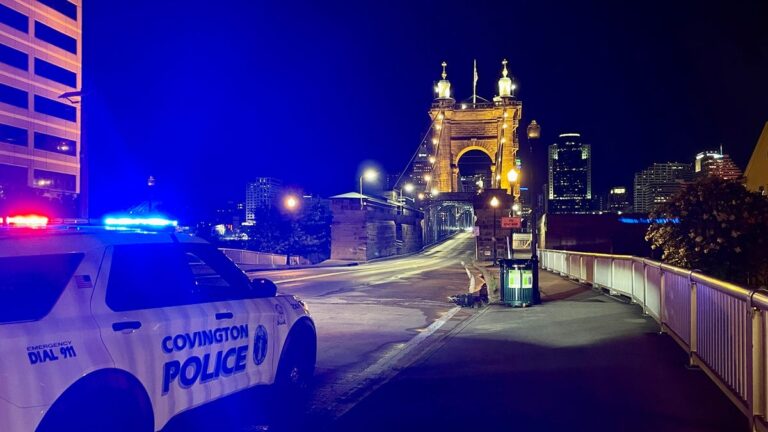What I witnessed on the Kentucky side of the bridge was not public safety. It was force. It was an escalation. It was violence
Covington police subdue multiple people during Roebling Bridge protest
Videos show Covington officers subduing people during the July 17 protest. Police said they were “met with open hostility” when dispersing the group.
Gracie Shanklin, Provided
It was the injustice of Imam Ayman Soliman’s arrest that called us to the base of the John A. Roebling Bridge. I do not know the imam personally, but I have listened to the testimony of mutual friends and read the media coverage describing him as a man of deep faith, as someone who has prayed with families at Children’s Hospital through their darkest hours. I have also learned that he sought asylum in this country, fleeing state-sanctioned violence in search of refuge. He came here believing in America’s promise of liberty and justice for all.
What happened to him, and what happened to us on that bridge, is a betrayal of that promise.
We gathered at the foot of the bridge to speak, to listen, to pray. Then we began a peaceful, symbolic walk. The Ohio River has long been a place of crossings in pursuit of liberation. Many formerly enslaved people crossed that very same river, some in the dead of night, others hiding among cargo on steamboats, all escaping the state-sanctioned bondage and horrors of slavery. On July 17, we crossed to remind our community that we can still be a place where people come in pursuit of justice and liberation.
If you are reading this, perhaps you have seen the videos, heard the accounts, or maybe you stood beside me. Covington police has said officers initially attempted to connect with the protest’s organizer but were “met with open hostility and threatening behavior.” And that while the department supports the public’s right to peaceful assembly, “threatening officers and blocking critical infrastructure…presents a danger to all involved.” The Covington police chief says a thorough investigation is underway and “any misconduct found, it will be addressed.”
Covington police wanted to send us a message
What I witnessed on the Kentucky side of the bridge was not public safety. It was force. It was an escalation. It was violence.
I watched a man near me get punched in the head and neck. I saw people peacefully resisting, only to be dragged from railings and thrown to the ground. I have heard that an officer told one of our organizers, “On this side of the river, we do not f— around.”
That wasn’t just about crowd control; it was a message. A threat. It was an intentional contrast to the civil manner in which the Cincinnati Police Department engaged the same group of protestors. It was an assertion of power meant to make us sit down and shut up.
But history and faith teach us otherwise.
In every generation, people are asked to answer a sacred question once sung by Pete Seeger and the Freedom Singers: “Which side are you on?” Liberation or oppression? Justice or silence? Courage or compliance?
What happened to Soliman and what happened on that bridge are not isolated incidents. They are connected by a system that sees immigrants, Black people, Muslims, and dissenters as threats. We are not the threat. Injustice is the threat. Corruption is the threat. Empire is the threat.
The road to compliance is wide and easy. But the road to liberation is narrow, difficult and often costly.
Still, I choose the narrow road. I do not walk it alone, but with the elders who crossed bridges before me, to the families and courageous people who walked beside me. I walk it with the spirit of John Lewis urging us to make “good trouble.” I walk it in faith that justice, though delayed, is never denied by those who keep walking.
And now the question remains: When you look at what happened to Imam Ayman Soliman − and what happened to peaceful marchers on the Roebling Bridge − which road will you walk?
Rev. Nelson Pierce Jr. is an activist and the senior pastor of Beloved Community Church in Mt. Airy. He lives in Forest Park.

